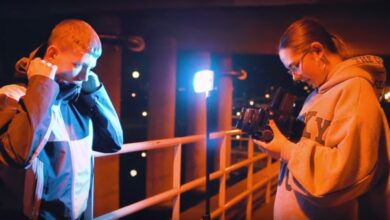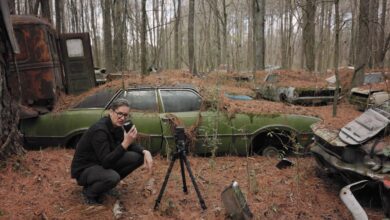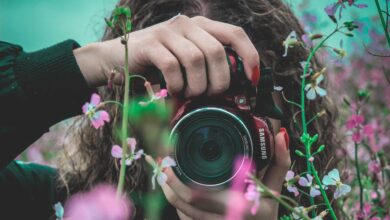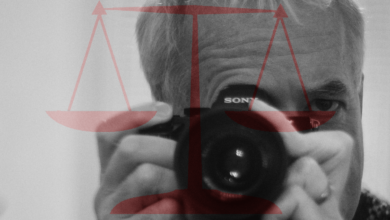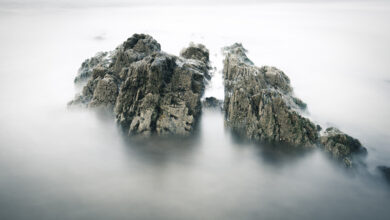Pushing Your Limits as an Introverted Photographer
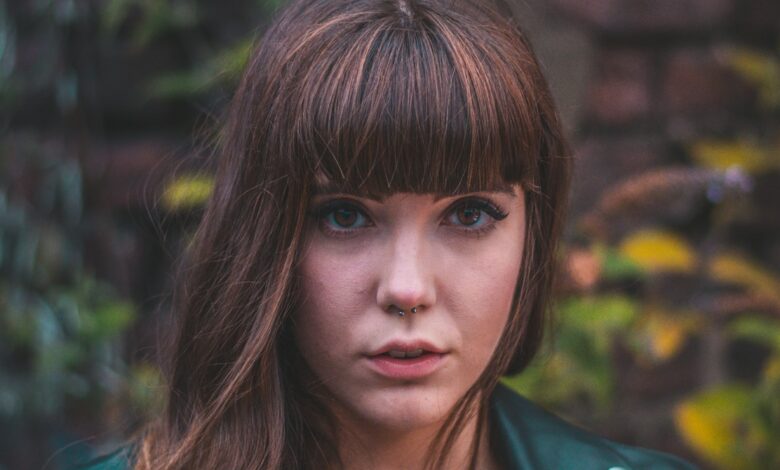
Does the thought of photographing people for the first time frighten you? It did for me a few years ago. As an introverted photographer who also suffers from depression and anxiety, I was petrified to make the step into portrait photography, but I was able to push through it and now I love it!
When I first started photography over eight years ago, all I wanted to do was photograph wildlife and landscapes. The thought of photographing people was terrifying to me. When I was at a party with people I had never met before, I was the kind of person to hang back and just have a chat with anyone I did know.
I am a quiet person in general, and I do not enjoy being front and center (well, unless I have had a few drinks and I get some Dutch courage, but that is another story).
The idea of photographing people was a big no-no for me. How could I direct them? What would they think of the images? What if they did not like them? What if they were mean? These were all questions that I would ask myself, plus many more, but part of me was still intrigued. I loved looking at different styles of portrait photography and I really wondered if I was capable of capturing images like the ones I see in newspapers, magazines, and online.
YouTube
YouTube can be such an amazing tool for learning new skills and has been a major catalyst in my photography career. Whether it has been looking at new locations, inspiration, tips and tricks, or just outright gear acquisition syndrome punishing myself looking at all the amazing gear I could never afford.
I remember several years ago, searching for portrait photography on YouTube and I came across Manny Ortiz’s channel. His channel was still relatively new with not many subscribers at the time, but his content was easy to follow for me. As more and more videos were released, I learned that he too was an introverted photographer, and that started to bring me hope.
In many of his early videos, his wife Diana was his main model, but Ortiz was already a successful photographer with other clients on his books. But it gave me the idea that if I were to have a go at portrait photography, then I should start with people I know and see how it feels directing them.
Using tips from Ortiz’s videos, or other channels that I found, I could look for more posing techniques, what lingo the photographers use, and how to make sure the model and myself are comfortable at all times.
The First Shoot
I contacted a few of my friends who I knew had modeled for other photographers I know, and I asked if they would be interested in collaborating on a shoot with me and explained my thoughts behind it. They were more than happy to oblige, so we proceeded to the planning stage.
What were we going to shoot? Where are we going to shoot? We settled on trying a smoke grenade shoot in a woodland in North Wales, so we put our money together and purchased 10 or so smoke grenades from Enola Gaye and set the date. A couple of my friends who are also photographers were also interested in getting involved, so we all chipped in.
I covered as much basis as possible ahead of the shoot, and I even reached out to the local emergency services, just to let them know we were having a photoshoot in this location with smoke grenades, so please do not send the fire service in case someone reports smoke from that location. The emergency services were really grateful for that heads up which was encouraging!
Having a couple of other photographers there on the day who were also good friends with the models was really helpful. The atmosphere was relaxed, and all of us would put our heads together for wardrobe decisions, posing, locations, etc.
We stayed for hours and had lots of fun. The creative ideas being thrown around were engaging and it did not take long for me to feel comfortable in those surroundings. I was shooting with my Nikon D500 and an old-style Tamron 70-200mm lens. Using a telephoto lens allowed me room to keep my distance from the models and control the compositions more, whilst also hoping for some nice bokeh using the lens’s compression.
I felt great, and I could not wait to get home and look at the images! At the time, I loved them! Looking back at them now, of course, they are not great, but it was the first go and I had just challenged my comfort zone for the first time so it was an all-around achievement.
Next Up
From that moment on, I felt like I needed to strike while the iron was hot and look for more opportunities to photograph people. At first, I would stick to photographing people I knew, but I then decided to join a networking event run by a local photographer shooting at an abandoned mansion.
I went by myself and my anxiety levels were through the roof. I entered the mansion and was greeted right away by the organizer and I was then introduced to the models and the other photographers who were there. My anxiety levels grew as I saw some of the gear that the other photographers had brought. They had some serious lighting equipment, with multiple strobes, soft boxes, and far more expensive cameras and lenses than me.
I was nervous, but I was determined not to be deterred. I had one camera body and two lenses, my 70-200mm and a cheap nifty fifty. I took a walk around the mansion and I tried to find rooms with the best natural light that I could as I knew I would struggle in some of the other rooms in the home.
I settled on a couple of rooms on the top floor that were appealing to me and also had lots of windows (albeit most of them were smashed). I headed back downstairs to the meeting area and was assigned my first model, my heart was racing, I was sweating (even though it was snowing outside), I probably looked like a ghost but I introduced myself and I led the model upstairs to the rooms I had scouted out.
With my voice trembling in fear, I croaked out some instructions to the model and began shooting. I was moving around the room like a newborn giraffe trying to find my feet, whilst looking for my compositions and firing away as many shots as I could. After 5 minutes, I paused for a drink and I went to show the back-of-camera images to the model. To my amazement, the model loved them and was praising me for my eye.
The ice was starting to break and I began to find my feet, my confidence was boosted from that interaction and it also taught me something valuable – keep in contact with the model, show them the images regularly and they might see something they are doing wrong and will want to correct it in the next shot.
As the day progressed, I got to work with several different models and after each experience, my confidence was growing. For the first half of the day, I could barely speak, but towards the end, I was giving instructions right, left, and center. The ideas in my head were flowing, and I also loved to find out what ideas the model had so we could work on them together.
My goal at the end of the day was to leave a great impression, make new friends and contacts, and also deliver images that they would love. They could see I was new and nervous, but they helped put me at ease, and I achieved all of my goals that day.
Ballet
A couple of years after the mansion shoot, I was becoming much more confident photographing people and one area that always interested me was dance photography, in particular urban ballet. I went on Instagram and searched for local dancers and I started sending a couple of messages out offering free photoshoots and explaining the images I could envision.
The dancers I contacted were very interested and we arranged to meet up in Liverpool for a photoshoot. Working alongside dancers will challenge your skills in a very good way because dancers demand perfection. It is not perfection from you as a photographer, but from them as a performer. Dancers will study an image you show them, and if they see that their foot position is slightly off, then you both keep trying until their form is perfect.
As a photographer, when capturing moving dancers, especially in leaps or other large movements, your timing needs to be pinpoint in line with the dancer. The rest is up to the dancer themselves, as they know whether their body position was right or wrong. The respect I have for dancers is massive!
I continued working with dancers across Liverpool and the North West UK as part of what I entitled “The Liverpool Ballet Project.” I wanted to photograph dancers in as many iconic locations as possible, and I had so many amazing plans and ideas in place. My work was published several times in national newspapers, which, for me, was the greatest honor I have experienced as a creator.
With several large epic dance shoots booked in my diary, plus my work was attracting attention from Liverpool City Council and further afield, things were looking up but then devastation hit: COVID-19.
The Present
COVID-19 canceled all of my plans as we were made to isolate in our homes and could not meet people out and about. My heart was broken, as were the dancers. I was lost and did not know what to do, for months my camera gear collected dust or I would just try other styles of photography such as products.
Just over a year into the epidemic, my wife and I moved from Liverpool to Scotland, and I focused on wildlife photography but a new opportunity was going to present itself.
I started receiving wedding inquiries, and I decided this would be a great opportunity so I worked out my pricing and now I have a few weddings under my belt with more to come.
Weddings are a different breed to other portrait shoots, and I have managed to use everything I have learned over the years and managed to translate it into photographing weddings. Seeing the bride and groom’s expressions when I show them the final images is without a doubt one of the most amazing moments as you see them fall in love with the results.
It is the ultimate challenge for an introverted photographer to capture someone’s special day, but it has taken several years for me to build up to this point, and it has taken a lot of learning and development over the years.
Push Your Limits
So, how can you push your limits as an introverted photographer? Here are a few of my tips to get you started:
- Start small: Begin photographing your loved ones or friends. It sounds simple enough, and it is to be honest, but it’s a massive help. Use the tools available to you such as YouTube, Instagram, Magazines, etc. to look at different poses and learn how to communicate your ideas to your models. Even showing the models screenshots of the pose can be a massive help if you struggle to explain your vision.
- Network: If you know of different photographers in your area, see if they offer networking events or studio days where you can go. You will learn so much, whether it is how to use studio lighting yourself, posing, and other tips and tricks. You will also begin to build connections and friends who you can learn from, or shoot with in the future. Not only that, but networking will expand your own reach so the models’ friends may see your work and want to shoot with you.
- Go long: Use a variety of lenses, especially telephoto, maybe from around 85-200mm is a good focal range for really nice portraits but also keeps a good distance from your model. Don’t go too long, though, as you do not want to be shouting at your model from a distance if you end up with a 600mm lens!
- Communication: Yes, it is scary, but it is vital. You will need to learn how to communicate effectively with your models, take a series of images of them and show them the results right away, talk to them and it will really break the ice. Collaborate together on what you both want to achieve from the session, receiving feedback throughout is good for you and good for the model.
- Bring a friend: When I am shooting with models, or weddings, etc., I usually have an assistant with me. The assistant is mostly my wife as we work well together on shoots, and I highly recommend having someone with you as a support network. Having a female assistant also works well, as my wife can assist with hair and makeup throughout the shoot. I also recommend that the model brings someone with them, so they feel safe and secure. There are a lot of horror stories out there of photographers being creepy, perverted towards models, etc., so it is absolutely paramount that your model is safe and feels comfortable at all times with you.
- Be kind: As touched on above, a model’s safety is the most important thing on any shoot. Refrain from touching the model and ask your assistant or their friend to help with the model’s hair, etc., if you see an issue. Be mindful of your language or saying anything inappropriate, giving models pet nicknames such as sexy, babe, etc. is a no-no!
Summary
There we have it, that is my story from being an introverted photographer to now, plus some tips along the way which I hope will help you. The important thing is just give it a go, start slow and see how you feel. If you enjoy it, keep practicing and see where it takes you. Without the likes of Manny Ortiz and others throughout the years, I never would have got to where I am now with portraits, and I still have a lot to learn but it is exciting!
Thank you, Manny!
